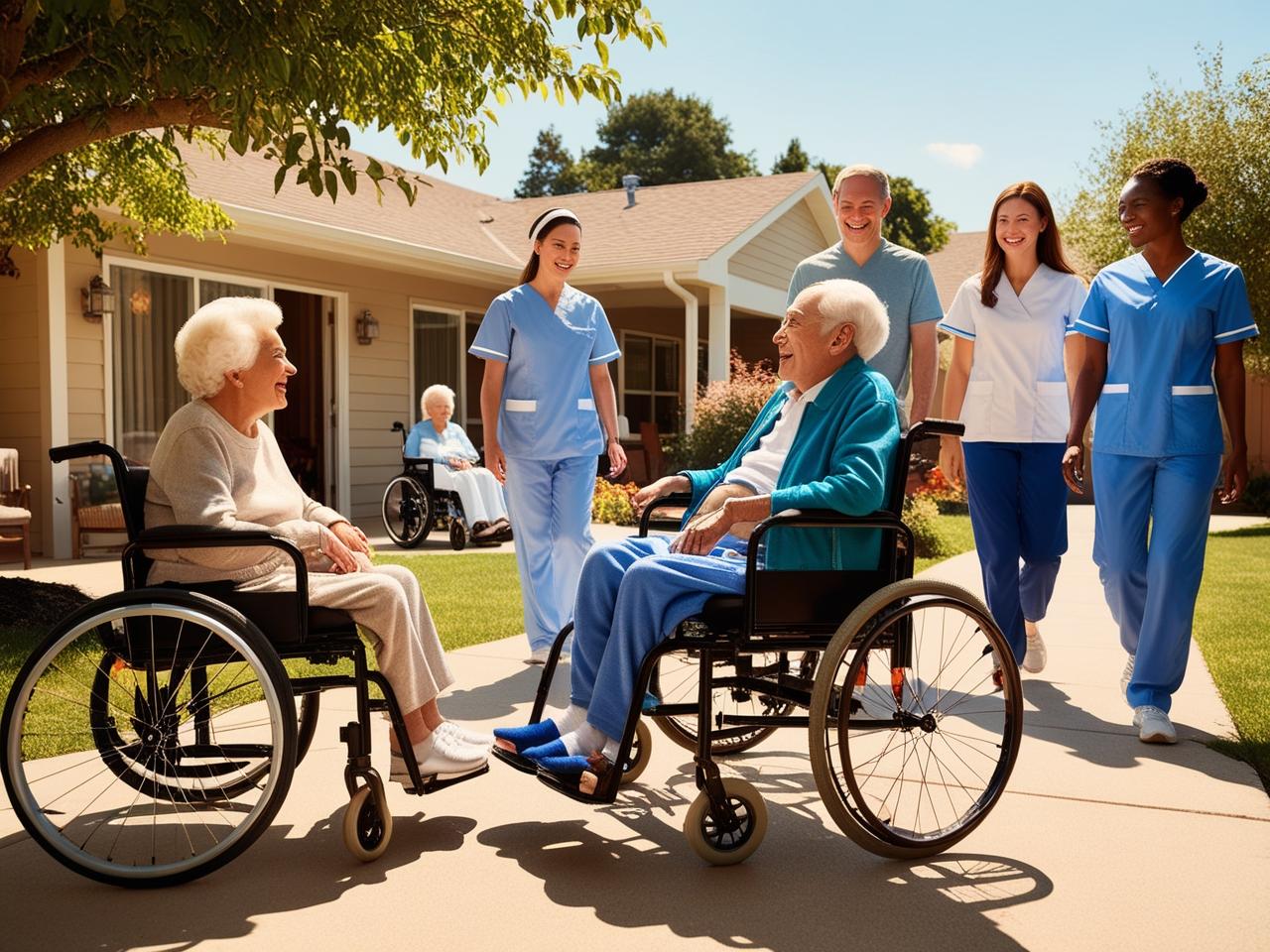As we transition through life, our needs and desires evolve. A once spacious home ideal for raising a family may gradually start to feel burdensome with the maintenance it entails. Tasks like yardwork can become exhausting, the upkeep of the house can consume precious time, and social interactions may lessen over time. This is the juncture where many older adults contemplate the idea of selling their home and relocating to an active senior living community.
However, making the decision to part ways with a beloved home and moving into a Senior Living Community can seem like a daunting prospect. It marks a significant life transition, and it’s completely natural to have reservations. The purpose of this article is to guide you through this decision-making process by delving into the advantages and disadvantages of transitioning to an active senior living community where independent living is encouraged.
What is an Active Senior Living Community?
Active Senior Living Communities, commonly referred to as 55+ communities or independent living communities, provide a vibrant lifestyle for active and independent seniors seeking freedom from the responsibilities of homeownership. Setting themselves apart from assisted living facilities and other medically oriented residences, these communities offer residents the opportunity to own their homes while enjoying a range of amenities.
One key aspect of these communities is maintenance-free living, which includes services such as yardwork, housekeeping, and home repairs, all managed by the homeowners association to free residents from these burdens. In addition, residents can participate in various social engagement opportunities, including social events, clubs, and activities that promote a sense of community and connection. Amenities like dining facilities and theaters are shared among residents, fostering a lively and social environment.
Furthermore, many active senior living communities prioritize fitness and wellness, providing on-site fitness centers, swimming pools, and organized fitness classes to help residents maintain an active and healthy lifestyle. Residents also have access to group fitness activities and trips to historical or recreational destinations, enhancing their overall well-being and social interactions.
5 Benefits of Moving to an Active Senior Living Community
As seniors reach a new chapter in their lives, transitioning to an active senior living community can offer an array of benefits that promote well-being and enhance overall quality of life. Here are five key advantages of making the move:
- Social Opportunities: Active senior living communities provide a vibrant social atmosphere where residents can engage in a variety of group activities and events. From fitness classes to hobby groups and cultural outings, there are ample opportunities to connect with peers and form new friendships.
- Maintenance-Free Living: Say goodbye to the hassles of home maintenance and yard work. In an active senior living community, residents can enjoy a maintenance-free lifestyle, allowing them to focus on pursuing their interests and hobbies without the burden of household chores.
- Enhanced Wellness Programs: Staying active and healthy is a top priority in senior living communities. Residents have access to fitness centers, wellness programs, and nutritional services designed to support their physical, mental, and emotional well-being. With expert guidance and personalized care plans, seniors can lead fulfilling and healthy lifestyles.
- On-Site Amenities: Senior living communities often feature a wide range of on-site amenities to cater to residents’ needs and preferences. From swimming pools and walking trails to libraries and craft rooms, these communities offer a diverse array of facilities that promote an enriched and engaging lifestyle.
- Peace of Mind: One of the most significant benefits of moving to an active senior living community is the peace of mind that comes with knowing there is assistance and support available if needed. Whether it’s onsite medical care, emergency response systems, or supportive staff members, residents can rest easy knowing that their well-being is a top priority.
By embracing the opportunities and advantages of active senior living communities, older adults can cultivate a fulfilling and enriching lifestyle that supports their individual needs and preferences. Make the transition today and embark on a new chapter filled with camaraderie, wellness, and vibrant living.
Challenges in Transitioning to an Active Senior Living Community
As one embarks on the journey of moving to an active senior living community, it’s essential to be prepared for the challenges that may arise during this transition. Moving to a new environment can be both exciting and daunting, but understanding and addressing potential obstacles can help make the adjustment smoother. In this chapter, we will explore some common challenges that seniors face when moving to an active senior living community and provide insights on how to overcome them.
Understanding the Challenges:
- Emotional Adjustment: Moving from a familiar living space to a new community can trigger a range of emotions, including nostalgia, anxiety, and even sadness. It’s normal to feel a sense of loss or uncertainty during this transition.
- Social Dynamics: Building new relationships and social connections in a new environment can be challenging, especially for those who are used to a tight-knit community or have limited experience with meeting new people.
- Physical Logistics: The practical aspects of moving, such as downsizing personal belongings, coordinating the relocation process, and adjusting to a different living space, can be physically demanding and overwhelming.
- Maintaining Independence: Seniors may worry about losing their sense of independence when moving to a communal setting, where there may be shared amenities or support services available.
Strategies for Overcoming Challenges:
- Embrace Change: Recognize that transitioning to a senior living community is a significant life change and give yourself permission to feel a range of emotions. Find ways to stay positive and focus on the new opportunities and experiences that await you.
- Get Involved: Engage with the activities, events, and social opportunities within the community to meet new people and build connections. Participating in group activities or clubs can help you feel more integrated and part of the community.
- Seek Support: Don’t hesitate to lean on friends, family, or the community staff for support during the transition. Talking about your feelings and concerns can help alleviate stress and provide a sense of reassurance.
- Personalize Your Space: Make your new living space feel like home by decorating it with familiar items, photos, and mementos. Creating a comfortable and personalized environment can help you adjust to the new surroundings.
- Set Realistic Expectations: Understand that it may take time to fully settle into your new lifestyle and routine. Be patient with yourself and allow for a period of adjustment as you navigate the challenges of transitioning to a senior living community.
By acknowledging these challenges and implementing strategies to address them, seniors can navigate the transition to an active senior living community with greater ease and confidence. Embracing the opportunities for social engagement, personal growth, and enhanced well-being that come with this new chapter in life can lead to a fulfilling and enriching experience in a senior living community.
Navigating the Decision: Is Active Senior Living Right for You?
As we age, the decision of whether to transition to an active senior living community becomes increasingly relevant. However, this choice is not a one-size-fits-all solution. It requires a thoughtful analysis of personal needs, lifestyle preferences, and financial circumstances.
Factors to Consider
- Assess Your Current Health: Maintaining good health is essential for a fulfilling retirement. If you are currently healthy and independent but seek enhanced social interactions and reduced household responsibilities, an active senior living community could be an ideal match.
- Anticipate Future Needs: Considering potential future care requirements is crucial. Some senior communities offer a range of care services, allowing residents to seamlessly transition to higher levels of assistance as needed, ensuring continuity and comfort as they age.
- Reflect on Your Personality and Social Preferences: For those who thrive in social settings and value engaging experiences, a community that fosters a vibrant social environment with diverse activities and events may hold significant appeal.
- Evaluate Your Support Network: The presence of a robust support network can greatly influence your decision. Assess whether you have close family members or friends who can easily visit and provide assistance when needed, enhancing your sense of security and well-being.
- Making an Informed Choice: Choosing to move to an active senior living community is a significant decision that necessitates thorough deliberation. By considering the aforementioned factors, you can make an informed choice tailored to your unique circumstances and aspirations.
Conclusion
The decision to transition to an active senior living community is deeply personal and should be based on a careful evaluation of individual needs and preferences. By assessing factors such as health status, future care requirements, social inclinations, and support networks, individuals can make a well-informed choice that enhances their quality of life in their later years.
Frequently Asked Questions
How do I know if an active senior living community is suitable for me?
- To determine if an active senior living community is suitable for you, it is important to consider various factors. Firstly, assess your lifestyle goals and preferences – do you enjoy social activities, outdoor excursions, and an active lifestyle? Evaluate the services and amenities offered by the community – are they aligned with your needs, such as fitness facilities, recreational programs, and dining options?
- Additionally, consider the location, cost, and atmosphere of the community to ensure it fits your desired lifestyle. Lastly, visit the community in person, interact with current residents, and attend an event to get a feel for the community’s culture and see if it resonates with your interests and values.
What amenities are typically offered in active senior living communities?
In active senior living communities, a range of amenities is typically offered to cater to the needs and preferences of residents. Some common amenities include:
1. Fitness centers and exercise classes to promote physical well-being.
2. Social and recreational activities such as games, excursions, and community events to foster social connections.
3. Dining facilities with nutritious meal options and dining plans.
4. Housekeeping and maintenance services to ensure a comfortable living environment.
5. Transportation services for errands, appointments, and outings.
6. On-site medical services or access to healthcare providers.
7. Pet-friendly accommodations and amenities for residents with furry companions.
8. Outdoor spaces, gardens, and walking paths for enjoying nature and outdoor activities.
9. Educational programs, classes, and workshops to support lifelong learning.
10. Security features and 24/7 staff availability for peace of mind.
These amenities are designed to enhance the quality of life for residents in active senior living communities and promote a sense of community and well-being.
Are there financial considerations to keep in mind when moving to such a community?
- Yes, there are important financial considerations to keep in mind when moving a loved one to an assisted living community. Some key factors to consider include the cost of the monthly fees, additional services and care that may incur extra charges, whether long-term care insurance or Medicaid might help cover expenses, potential for rate increases over time, and the options for financing the move such as private pay, selling assets, or utilizing government assistance programs. It is essential to carefully review the financial aspects with the assisted living facility and consult with a financial advisor to ensure a smooth transition for your loved one.
How can I involve my family in the decision-making process?
Involving your family in the decision-making process when transitioning a loved one to assisted living is a crucial step to ensure everyone feels heard and supported throughout the process. Here are some steps you can take to involve your family effectively:
1. Open communication: Initiate an open dialogue with all family members about the need for assisted living, emphasizing that everyone’s input and concerns are valuable.
2. Family meetings: Schedule regular family meetings to discuss the options, share information about different assisted living facilities, and collectively make decisions.
3. Listen actively: Create a safe space for all family members to express their thoughts, fears, and preferences regarding the transition.
4. Assign tasks: Divide responsibilities among family members based on their strengths and availability, such as researching facilities, handling paperwork, or coordinating moving logistics.
5. Respect differing opinions: Acknowledge that each family member may have a unique perspective on the situation, and work together to find common ground and make decisions that prioritize your loved one’s well-being.
6. Seek professional guidance: Consider involving a mediator, counselor, or social worker to facilitate family discussions and provide unbiased guidance when needed.
By engaging your family members in a collaborative and respectful manner, you can navigate the challenging process of transitioning a loved one to assisted living together, ensuring that your loved one receives the best possible care and support.
What steps should I take to prepare for the transition to an active senior living community?
Transitioning a loved one to an active senior living community can be a big step, but careful preparation can help alleviate stress. Here are some steps you can take to prepare for this transition:
1. Research and Visit Communities: Start by researching different active senior living communities in your area. Visit multiple communities to get a feel for their amenities, activities, and overall atmosphere.
2. Assess Care Needs: Determine your loved one’s care needs and preferences. Consider factors such as assistance with daily activities, medical needs, social interaction, and level of independence.
3. Plan Finances: Understand the costs associated with senior living communities and create a financial plan. Consider factors such as monthly fees, additional services, insurance coverage, and long-term care expenses.
4. Declutter and Downsize: Help your loved one declutter and downsize their belongings to prepare for a smaller living space. Encourage them to donate, sell, or store items that won’t fit in their new residence.
5. Coordinate with Healthcare Providers: Communicate with your loved one’s healthcare providers to ensure a smooth transition of medical records, prescriptions, and care plans to the new community.
6. Involve Your Loved One: Involve your loved one in the decision-making process and encourage open communication. Address any concerns or fears they may have about the transition.
7. Create a Moving Plan: Develop a moving plan that outlines the logistics of the transition, including timelines, packing arrangements, transportation, and setting up utilities in the new residence.
8. Establish a Support System: Reach out to family members, friends, or support groups for emotional support during the transition. Consider hiring a professional mover or organizer to facilitate the process.
By following these steps and approaching the transition with care and consideration, you can help ensure a successful move to an active senior living community for your loved one.
Have Questions About How to Quickly Sell Your Home for Cash?
Unlock a Fast and Stress-Free Home Sale with Golden Heart Senior Solutions
Are you looking to sell your home swiftly and seamlessly? Take the first step toward a fast, stress-free sale of your home by contacting Golden Heart Senior Solutions. Making the decision to sell your home can be overwhelming, but with the right partner by your side, the process can be incredibly smooth and hassle-free.





Leave a Reply